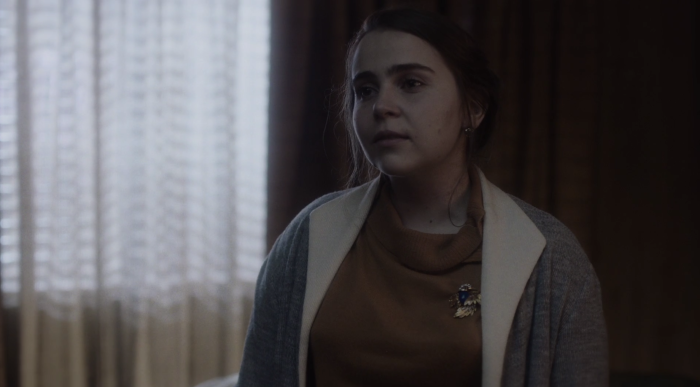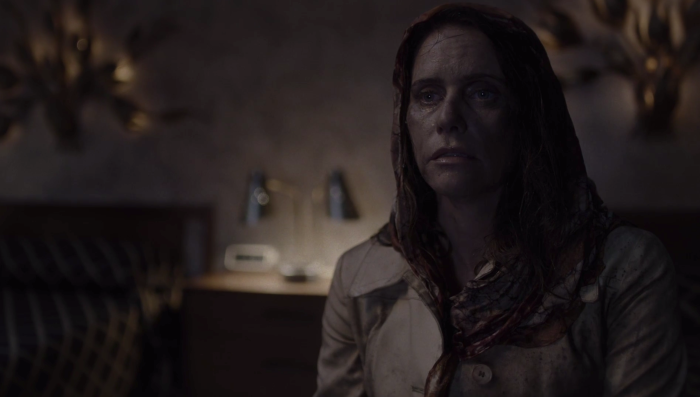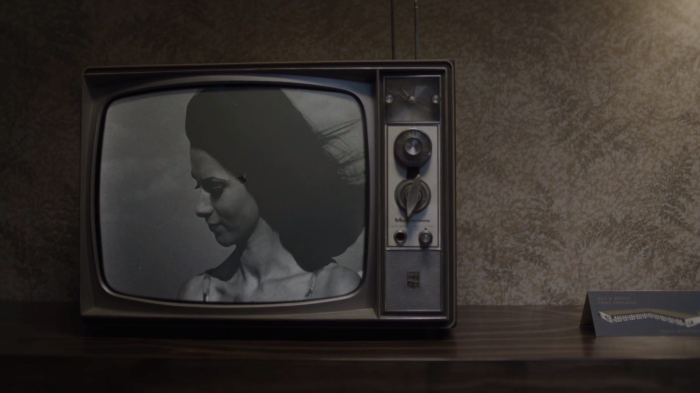'Room 104' Review: 'Phoenix' Takes The Anthology Series Back To 1969
(Each week, we'll kick off discussion about Room 104 by answering one simple question: what's the strangest thing in Room 104?)For the second time this season, Room 104 traveled back in time. "Phoenix" takes place in the late 1960s, just moments after a plane crash. The sole survivor is trying to make sense of what happened to her, and decide what to do next. Luckily, Liza arrives to help her choose a path forward.
What’s the Strangest Thing in Room 104? Liza
The first character we meet in "Phoenix" is not a person but a fly. The bug buzzes around Room 104, landing on curtains, motel art, and a small black and white television set that exist in another time: 1969. Once the fly finally settles, the camera slowly pans up to Joan (Amy Landecker), a shellshocked woman sitting on the edge of a bed. She's still wearing her coat and scarf. Her hands are caked in mud. And it's obvious something horrible happened to her.Joan is the sole survivor of a plane crash that's all over the news. Every passenger is presumed dead, and Joan isn't doing anything to challenge that narrative. She checked into the motel under a fake name and has not called her husband or children to say she's okay. During her stay, she's mostly been sleeping, crying, and having quiet time with the fly. But things take a turn once Liza (Mae Whitman) shows up.Joan initially thinks Liza is a housekeeper and tells her to go away. But Liza is no maid – and she knows Joan's real name. She begs Joan to let her in so she can check her vitals and give her some food. Rattled, Joan hangs up the phone on her secret lover and opens the door.Joan doesn't trust Liza, with good reason. Liza is impossibly vague about who she actually is. When Joan asks her if she's a paramedic, she says she was "once trained as a medic, yes." When Joan suspects she's a reporter trying to get a scoop, Liza merely agrees that would make sense. There's an eerie calm about her that makes her feel slightly sinister. And Liza has an edge.She somehow knows everything that happened to Joan, right down to the precise dilemma running through her head. Should Joan return to her family or begin a new life? Liza says it's time to choose, and cruelly suggests that Joan's kids would be fine without her. That's when Joan snaps, strangling Liza until she passes out. But Liza isn't dead. She merely has to go. She tells Joan to think hard about what she wants as a blinding white light from the door engulfs her. Liza vanishes, and the whole scene shifts back to the beginning, with Joan watching TV. The fly lands on her face this time. Without even blinking, she swats it dead.
Hallucinations and Head Wounds
Liza appears to be an otherworldly being, but she might also be a figment of Joan's imagination. Although she seems to be in good shape, Joan did not escape the crash unscathed. We see her cleaning a large gash on her arm – and that's the least of her worries. Liza asks why there's so much blood on her sheets, suggesting a larger, more serious wound that Joan is hiding. Joan also seems to have pain in the back of her head. Did she sustain a traumatic brain injury? A montage that plays as Liza departs certainly implies so. As images of Joan's face, eyes, and memories of the crash flicker in rapid succession, the camera moves towards the back of her head, which is matted in blood.The whole encounter between Joan and Liza may be the feverish hallucinations of a dying woman. But her decisive swat of the fly suggests she's at least made a decision about her immediate future.
A Sign of the Times
"Phoenix" riffs on Cold War fear and paranoia through the broadcast on Joan's TV. She's watching innocuous footage of a woman on the beach, but the male voiceover speaks ominously about what will happen to her when the sun goes away. This is interrupted by an emergency signal, which is later remixed into Joan's frenzied montage. She may be safe for now, but threat of danger is all around her.These stylistic flourishes help justify the time shift to a degree. But Room 104's period pieces have done a subpar job of engaging with the social contexts of their eras. Joan is a married woman having an affair in 1969, a time when sexual mores were completely in flux. But her conversation with her lover feels no different than one in 2017. Also, why was she even on the plane without her family? Was she visiting this secret boyfriend? Taking a work trip? Joan is doing several things that weren't exactly commonplace for women in the 1960s, but "Phoenix" doesn't seem interested in grappling with the implications.There are only four episodes left in this season, so I'm not sure we'll get another period piece from Room 104 this year. But moving forward, the series should use time shifts to tell unique stories, not just change the wall art.
